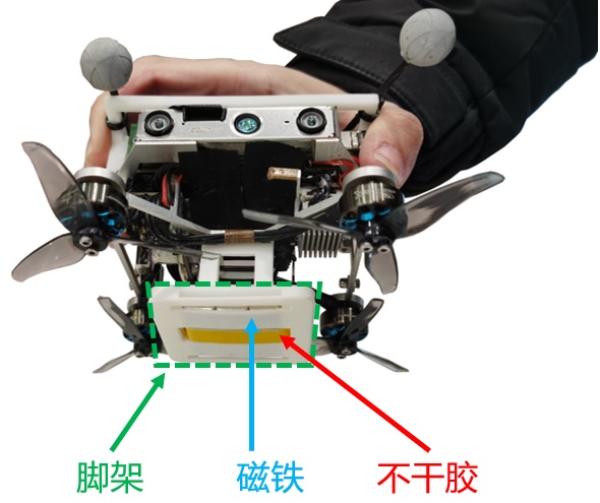

Recently, a new generation of micro-aerial robots developed by Gao Fei's team from the School of Control Science and Engineering of Zhejiang University has taken another step towards this goal. These palm-sized miniature aerial robots have successfully achieved autonomous flying and falling to planes with different inclination angles and distances in indoor environments, as well as vehicle-mounted and hand-held mobile platforms. The little guys can plan the optimal flight and landing trajectory in a very short time, adjust the terminal attitude and flight speed independently, and complete the flight and landing task smoothly and safely.
 Previously, the team has successfully developed miniature and fully autonomous aerial robots that can fly in groups in highly chaotic wild environments based on limited information provided by onboard sensors. The relevant results were published in the form of cover papers in the international top scientific journal "SCIENCE ROBOTICS" in May this year.
Previously, the team has successfully developed miniature and fully autonomous aerial robots that can fly in groups in highly chaotic wild environments based on limited information provided by onboard sensors. The relevant results were published in the form of cover papers in the international top scientific journal "SCIENCE ROBOTICS" in May this year."The significance of studying aerial robots flying to different platforms is to save energy consumption when the robot performs tasks such as monitoring, sampling and charging." Ji Jialin, one of the main participants in the study and a doctoral student at the School of Control Science and Engineering at Zhejiang University, told The Paper (www.thepaper.cn) introduction.
"The existing methods of domestic and foreign researchers usually artificially give the robot terminal posture and speed, which easily leads to the conflict between the dynamic feasibility and the safety of obstacle avoidance when the robot does not have sufficient space." Ji Jialin "Furthermore, these methods cannot handle complex constraints without guaranteeing efficient computation," The Paper told The Paper.
Generally, for an aerial robot, there are three requirements for an optimal flight and landing trajectory. First of all, the robot must be able to autonomously adjust the terminal state before falling, which includes autonomously calculating the flight time of the trajectory and the speed before falling.
Secondly, the robot must be able to safely avoid obstacles, such as not touching the ground and other obstacles during flight, and at the same time only contacting the landing platform at the last moment, which requires complex rigid body motion planning. Finally, due to the error of system perception and the motion of the mobile platform itself, the flight trajectory of the robot needs to be re-planned at high frequency.
Based on these considerations, the team proposes an efficient joint optimization method that can generate space-time optimal flight and fall trajectories that meet the above requirements. Compared with the existing scheme, this method can allow the aerial robot to automatically adjust the end state, and under the premise of satisfying the dynamic feasibility and obstacle avoidance safety, the tangential speed of the flying end can be minimized, so as to minimize the robot and the Scratch the platform. This feature is particularly important for miniature aerial robots and for flying and landing tasks in cramped environments.
Furthermore, the team's method uses a flexible optimization variable transformation strategy that can both eliminate complex end constraints and reduce the dimensionality of the optimization variables. At the same time, this method enables the robot to fly smoothly and safely to the target plane through an accurate rigid body kinematic model when approaching the target.
In the published experimental video, the researcher walks slowly through the room holding an iron-containing whiteboard. The inclination angle of the whiteboard varies from horizontal to vertical. In each scene, the micro-aerial robot flies through a path. After that, it accurately and dexterously landed on the whiteboard. According to reports, the generation time of the robot's flying and falling trajectory is within 20 milliseconds, and the re-planning using hot start in the experiment only takes 2 milliseconds. In contrast, the method using nonlinear model predictive control to achieve similar effects requires 10 times. above calculation time.
 There is room for further improvement in this research in the future. Ji Jialin told The Paper that the team's current experiments are all done under indoor conditions, and a matching motion capture system (reflective ball, infrared device, etc.) is needed to help the aerial robot identify and locate the target. In addition, the speed of the mobile platform is still relatively limited, limited to less than 1 m/s. In the future, with the improvement of related systems, aerial robots may be able to achieve higher-precision autonomous identification and positioning of flying targets, thereby challenging more flying and landing tasks in a wider space.
There is room for further improvement in this research in the future. Ji Jialin told The Paper that the team's current experiments are all done under indoor conditions, and a matching motion capture system (reflective ball, infrared device, etc.) is needed to help the aerial robot identify and locate the target. In addition, the speed of the mobile platform is still relatively limited, limited to less than 1 m/s. In the future, with the improvement of related systems, aerial robots may be able to achieve higher-precision autonomous identification and positioning of flying targets, thereby challenging more flying and landing tasks in a wider space.Related Posts
0 Comments
Write A Comments
